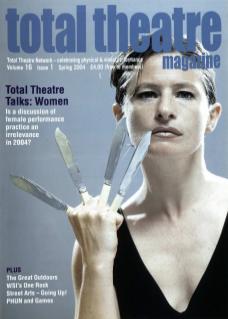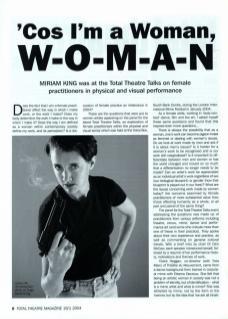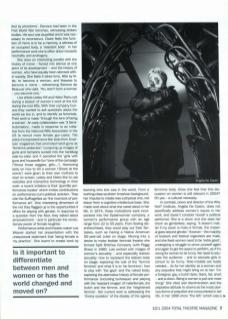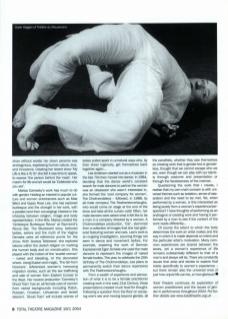Does the fact that I am a female practitioner affect the way in which I make work, or the work I make? Does my body determine the work I make or the way in which I make it? Does the way I am defined as a woman within contemporary society define my work, and its perception? Is a discussion of female practice an irrelevance in 2004?
These are the questions that were put to women artists appearing on the panel for the latest Total Theatre Talks, an exploration of female practitioners within the physical and visual sector which was held at the Voice Box, South Bank Centre, during the London International Mime Festival in January 2004.
As a female artist, working in 'body-centred' dance, film and live art, I asked myself these same questions and found that this inspired even more questions...
There is always the possibility that as a woman, one's work can become pigeon-holed as feminist or dealing with women's issues. Do we look at work made by men and ask if it is about men's issues? Is it harder for a woman's work to be recognised and is our work still marginalised? Is it important to differentiate between men and women or has the world changed and moved on so much that a differentiation no longer needs to be made? Can an artist's work be appreciated as an individual artist's work regardless of sex (our biological blueprint) or gender (how that blueprint is played out in our lives)? What are the issues concerning work made by women today? Are concerns examined by female practitioners of more substantial value than those affecting humanity as a whole, or all part and parcel of the same thing?
The panel for the Total Theatre Talks event addressing the questions was made up of practitioners from various artforms including theatre, circus, mime, dance and performance art (and some who include more than one of these in their practice). They spoke about their own experience and practice, as well as commenting on general cultural trends. With a brief intro by chair Dr Dick McCaw, each speaker introduced herself, followed by a resume of her performance history, motivations and themes of work.
Claire Heggan, co-director (with Yves Marc) of Théâtre du Mouvement, came from a dance background then trained in corporeal mime with Étienne Decroux. She felt that being an artistic woman in society was not a problem of identity, but of identification – what is a mime artist and what is mime? She was attracted by mime, not by the form or the manner, but by the idea that ‘we are all inhabited by phantoms'. Decroux had been in the First World War trenches, witnessing broken bodies. His soul was stupefied and it was necessary to reconstruct. Claire feels the function of mime is to be a memory, a witness of an occupied body, a 'resistant body’. In her performance work she is often drawn towards neutrality and androgyny.
She drew an interesting parallel with the history of mime – forced into silence at one point of its development – and the history of women, who have equally been silenced within society. She feels it takes time, little by little, to become a woman, and likewise to become a mime – referencing Simone de Beauvoir who said, 'You aren't born a woman – you become one.’
Live artists Lesley Hill and Helen Paris met during a season of women's work at the ICA during the mid-90s. With their company Curious they wanted to ask questions about the world we live in, and to identify as feminists. Their work is made ‘through the lens of being a woman'. An early collaboration was 3 SemiAutomatics, made in response to an initiative from the National Rifle Association in the US to recruit more female gun-users. The piece incorporated bona fide texts from American magazines that promoted hand-guns as ‘feminine protection’ (conjuring up images of guns and tampons tucked into the handbag side-by-side) and it parodied the ‘girls with guns’ and ‘housewife fun' tone of the campaign (‘Shoot those veggies, girls...'). Harrowing texts on how to kill a woman (‘Shoot at the womb') were given to their own mothers to read on screen. Lesley and Helen like to use websites and interactive technology in their work: a recent initiative is their 'guerrilla performance locator' which invites contributions on performance-cum-political activism. They cite the Suffragettes as ‘the inventors of performance art'. One interesting dimension of the net they flagged up is the opportunities it offers for playing with gender. In response to a question from the floor, they talked about empowerment – and in particular the revolutionary power of female laughter.
Performance artist and theatre-maker Lois Weaver started her presentation with the unequivocal statement that ‘being female is my practice'. She learnt to create work by learning who she was in the world. From a working class southern American background, her impulse to create was a physical one, not drawn from a cognitive intellectual base. She made work about what she cared about in her life. In 1974, these motivations were incorporated into the Spiderwoman company, a women's performance group with an age range from 22 to 55 years. From feeling disenfranchised, they could play out their fantasies, such as having a Native American 55 year-old Juliet on stage. Moving into a desire to make lesbian feminist theatre she formed Split Britches Company (with Peggy Shaw) in 1980. Lois worked with images of women's sexuality – and especially lesbian sexuality: how to represent the lesbian body on stage; exploring the role of the ‘femme feminist' and ‘what it is to be feminine'; how to play with ‘the gaze' and the naked body; exploring the alternative history of female performance (including burlesque); and playing with the 'resistant images’ of male/female, the butch and the femme, and the ‘heightened femme'. Her current work is addressing the 'thorny question’ of the display of the ageing feminine body. Does she feel that this discussion on women is still relevant in 2004? Oh yes – a cultural necessity.
In contrast, clown and director of the Why Not? Institute, Angela De Castro, does not specifically address women's issues in her work, and doesn't consider herself a political performer. She is a clown and she sees her clown as genderless, saying, 'It doesn't matter if my clown is male or female, the material goes beyond gender.’ However, the majority of bookers and festival organisers are male, and she feels women need to be extra good, undergoing a struggle to prove yourself again and again to get the space to perform, as if it's wrong for women to be funny. We need to educate the audience – and to educate girls in school to be funny. Role-models are badly needed... As for her identity as a woman and any prejudice that might bring on to her: 'I'm a foreigner, gay, a butch dyke, black, fat, short – and a clown. Being a woman is just one more thing!’ She cited size discrimination and the pejorative attitude to clowns as the most obvious forms of prejudice she encountered in her life. In her 1990 show The Gift (which was a show without words) her clown persona was androgynous, expressing human nature, love, and innocence. Creating her recent show My Life is like a Yo Yo she felt it was time to speak, to expose 'the person behind the mask’. Her maxim for life and art would be 'Celebrate who you are'.
Marisa Carnesky's work has much to do with gender. Holding an interest in popular culture and women entertainers such as Mae West and Gypsy Rose Lee, she has explored burlesque and the showgirl in her work, with a parallel (and then converging) interest in the interplay between religion, image and body representation. In the 90s, Marisa created the Grotesque Burlesque Revue at Raymond's Revue Bar. The Bluebeard story, tattooed ladies, sailors and the myth of the Vagina Dentata were all reference points for the show. With Jewess Tattooess she explored taboos within the Jewish religion on marking the human body and on menstruation. She played with the notion of the 'scarlet woman' – naked and bleeding, or the decorated whore. Using illusion and magic, The Girl from Nowhere referenced women's harrowing migration stories, such as the sex trafficking and sale of women from Eastern Europe to the West. Her newest production Carnesky's Ghost Train has an all-female cast of women from varied backgrounds including Polish, Russian, Croatian, Lithuanian and Israeli descent. Ghost Train will include scenes of ladies pulled apart in unnatural ways who, by their sheer ingenuity, get themselves back together again...
Lea Anderson started out as a musician in the late 70s then moved into dance. In 1984, deciding that the dance world's constant search for male dancers to partner the women was an obsession she wasn't interested in she formed the 'cool company for women' The Cholmondeleys – followed, in 1988, by all-male company The Featherstonehaughs, who would come on stage at the end of the show and take all the curtain calls! Often, her male dancers were asked what it felt like to be a man in a company directed by a woman. A Cholmondeleys production, Car, stemmed from a collection of images that she had gathered featuring women and cars. Lea's work is an ongoing investigation, sourcing things not seen in dance and movement before. For example, exploring the work of German Expressionist Egon Schiele she used the male dancers to represent the images of naked female bodies. This year, to celebrate the 20th birthday of The Cholmondeleys, Lea plans to permanently switch their dance repertoires with The Featherstonehaughs.
From a wealth of experience and perception of what it is to be a female practitioner creating work in the early 21st Century, these presentations created much food for thought. Following a question from the floor on escaping one's sex and moving beyond gender, all the panellists, whether they saw themselves as creating work that is gender-led or genderless, thought that we cannot escape who we are, even though we can play with our identity through costume and presentation or through the facelessness of the internet.
Questioning the work that I create, I realise that my own main concern is with universal themes such as isolation, sense of separation and the need to be met. Yet, when performed by a woman, is this interpreted as being purely from a woman's experience/perspective? I have thoughts of performing as an androgyne or creating work and having it performed by a man to see if the content of the work reads differently...
Of course the extent to which the body determines the work an artist makes and the way in which it is made depends on intent and the particular artist's motivation. Many common experiences are shared between the sexes, yet a woman's experience of life remains substantially different to that of a man's and always will be. There are constantly issues that arise and stories to explore that relate specifically to women's experience – but there remain also the universal ones of just how unjust life can be, or how glorious!
Total Theatre continues its exploration of women practitioners and the issues of gender in performance throughout 2004. For further details see www.totaltheatre.org.uk



